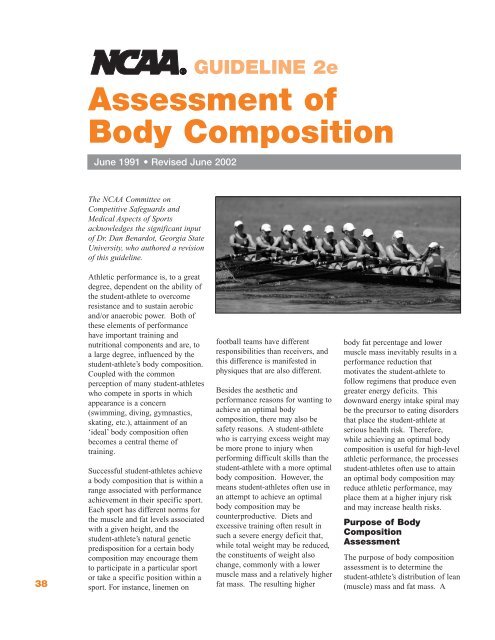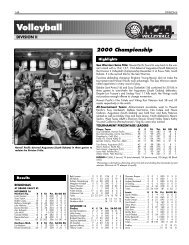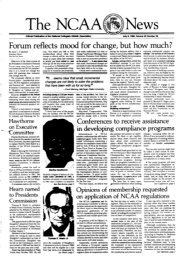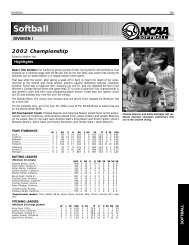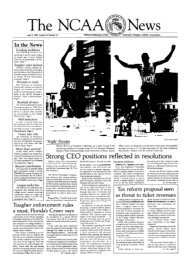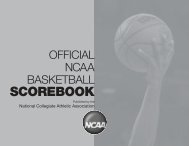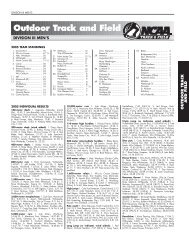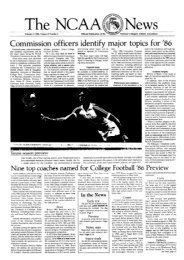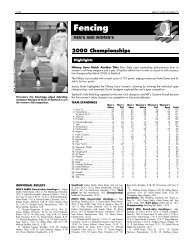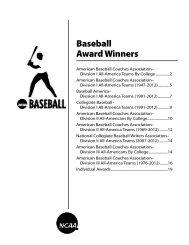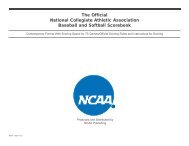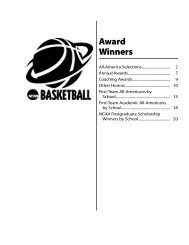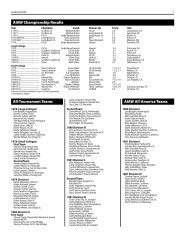Sports Medicine Handbook - NCAA
Sports Medicine Handbook - NCAA
Sports Medicine Handbook - NCAA
Create successful ePaper yourself
Turn your PDF publications into a flip-book with our unique Google optimized e-Paper software.
38<br />
Assessment of<br />
Body Composition<br />
June 1991 • Revised June 2002<br />
The <strong>NCAA</strong> Committee on<br />
Competitive Safeguards and<br />
Medical Aspects of <strong>Sports</strong><br />
acknowledges the significant input<br />
of Dr. Dan Benardot, Georgia State<br />
University, who authored a revision<br />
of this guideline.<br />
Athletic performance is, to a great<br />
degree, dependent on the ability of<br />
the student-athlete to overcome<br />
resistance and to sustain aerobic<br />
and/or anaerobic power. Both of<br />
these elements of performance<br />
have important training and<br />
nutritional components and are, to<br />
a large degree, influenced by the<br />
student-athlete’s body composition.<br />
Coupled with the common<br />
perception of many student-athletes<br />
who compete in sports in which<br />
appearance is a concern<br />
(swimming, diving, gymnastics,<br />
skating, etc.), attainment of an<br />
‘ideal’ body composition often<br />
becomes a central theme of<br />
training.<br />
Successful student-athletes achieve<br />
a body composition that is within a<br />
range associated with performance<br />
achievement in their specific sport.<br />
Each sport has different norms for<br />
the muscle and fat levels associated<br />
with a given height, and the<br />
student-athlete’s natural genetic<br />
predisposition for a certain body<br />
composition may encourage them<br />
to participate in a particular sport<br />
or take a specific position within a<br />
sport. For instance, linemen on<br />
GUIDELINE 2e<br />
football teams have different<br />
responsibilities than receivers, and<br />
this dif fer ence is manifested in<br />
physiques that are also different.<br />
Besides the aesthetic and<br />
performance reasons for wanting to<br />
achieve an optimal body<br />
composition, there may also be<br />
safety reasons. A student-athlete<br />
who is carrying excess weight may<br />
be more prone to injury when<br />
performing difficult skills than the<br />
student-athlete with a more optimal<br />
body composition. However, the<br />
means student-athletes often use in<br />
an attempt to achieve an optimal<br />
body composition may be<br />
counterproductive. Diets and<br />
excessive training often result in<br />
such a severe energy deficit that,<br />
while total weight may be reduced,<br />
the constituents of weight also<br />
change, commonly with a lower<br />
muscle mass and a relatively higher<br />
fat mass. The resulting higher<br />
body fat percentage and lower<br />
muscle mass inevitably results in a<br />
performance reduction that<br />
motivates the student-athlete to<br />
follow regimens that produce even<br />
greater energy deficits. This<br />
downward energy intake spiral may<br />
be the precursor to eating disorders<br />
that place the student-athlete at<br />
serious health risk. Therefore,<br />
while achieving an optimal body<br />
composition is useful for high-level<br />
athletic performance, the processes<br />
student-athletes often use to attain<br />
an optimal body composition may<br />
reduce athletic performance, may<br />
place them at a higher injury risk<br />
and may increase health risks.<br />
Purpose of Body<br />
Composition<br />
Assessment<br />
The purpose of body composition<br />
assessment is to determine the<br />
student-athlete’s distribution of lean<br />
(muscle) mass and fat mass. A


